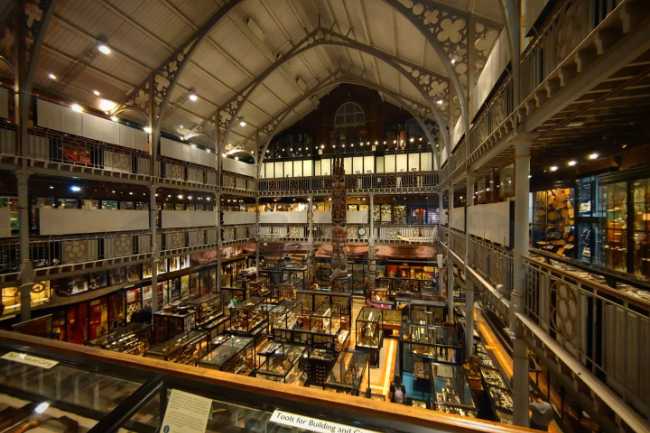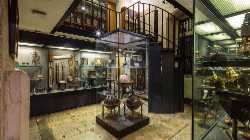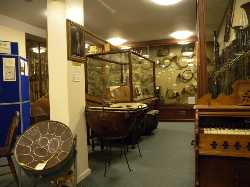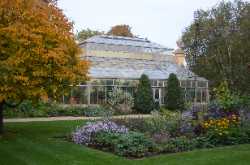Pitt Rivers Museum

Founded in 1884, the Pitt Rivers Museum in Oxford houses one of the world’s most remarkable collections of archaeology and anthropology, with over half a million objects, photographs, and manuscripts from every corner of the globe. Accessed through the Oxford University Museum of Natural History, it is renowned for its distinctive “typological” displays, where artefacts are arranged by function rather than geography or era, revealing fascinating parallels across cultures. From ceremonial masks and weaponry to textiles, tools, and musical instruments, the dense glass cases invite close study and spark curiosity about human creativity and adaptation. The museum also confronts the complex histories of its collections, engaging in collaborative projects with source communities and re‑examining its colonial legacies. Free to enter, it remains a place of discovery, dialogue, and reflection, where visitors can explore the diversity of human experience and the shared ingenuity that connects societies across time and place.
Oxford United KingdomThe Pitt Rivers Museum is located on South Parks Road in Oxford, adjacent and attached to the Oxford University Museum of Natural History, with the address OX1 3PP. It is only accessible through the Museum of Natural History building, sharing the same Victorian neo-Gothic architecture and offering a seamless visit between these two renowned museums. The Pitt Rivers Museum is famous for its vast and diverse archaeological and anthropological collections, displayed in densely packed cases that create a unique and immersive atmosphere. Nearby, visitors can explore other University of Oxford landmarks including the Museum of Natural History, the Bodleian Library, and the University Parks. The museum's central position also places it within easy walking distance of Oxford’s historic city center, offering a rich cultural experience along with nearby cafes, shops, and green spaces. The museum features a welcoming café and hosts a variety of exhibitions and events throughout the year.
 Ashmolean Museum
Oxford
Ashmolean Museum
Oxford
 Museum of Oxford
Oxford
Museum of Oxford
Oxford
 Oxford University Museum of Natural History
Oxford
Oxford University Museum of Natural History
Oxford
 History of Science Museum
Oxford
History of Science Museum
Oxford
 Bate Collection of Musical Instruments
Oxford
Bate Collection of Musical Instruments
Oxford
 Science Oxford Centre
Oxford
Science Oxford Centre
Oxford
 The Story Museum
Oxford
The Story Museum
Oxford
 Oxford Illusion Museum
Oxford
Oxford Illusion Museum
Oxford
 Abingdon County Hall Museum
Oxford
Abingdon County Hall Museum
Oxford
 The painted room
Oxford
The painted room
Oxford
 Christ Church Picture Gallery
Oxford
Christ Church Picture Gallery
Oxford
 Convocation House
Oxford
Convocation House
Oxford
 Oxford Bus Museum
Oxford
Oxford Bus Museum
Oxford
 Oxford Playhouse
Oxford
Oxford Playhouse
Oxford
 New Theatre Oxford
Oxford
New Theatre Oxford
Oxford
 Pegasus Theatre
Oxford
Pegasus Theatre
Oxford
 The North Wall Arts Centre
Oxford
The North Wall Arts Centre
Oxford
 Burton Taylor Studio
Oxford
Burton Taylor Studio
Oxford
 Modern Art Oxford
Oxford
Modern Art Oxford
Oxford
 Ovada
Oxford
Ovada
Oxford
 Sarah Wiseman Galler
Oxford
Sarah Wiseman Galler
Oxford
 Castle Fine Art Oxford
Oxford
Castle Fine Art Oxford
Oxford
 Oxford Castle & Prison
Oxford
Oxford Castle & Prison
Oxford
 The Grandpont House
Oxford
The Grandpont House
Oxford
 Christ Church College
Oxford
Christ Church College
Oxford
 Radcliffe Camera
Oxford
Radcliffe Camera
Oxford
 Sheldonian Theatre
Oxford
Sheldonian Theatre
Oxford
 Carfax Tower
Oxford
Carfax Tower
Oxford
 Martyrs’ Memorial
Oxford
Martyrs’ Memorial
Oxford
 Bridge of Sighs
Oxford
Bridge of Sighs
Oxford
 University Parks
Oxford
University Parks
Oxford
 Christ Church Meadow
Oxford
Christ Church Meadow
Oxford
 South Park
Oxford
South Park
Oxford
 Port Meadow
Oxford
Port Meadow
Oxford
 Oxford Botanic Garden
Oxford
Oxford Botanic Garden
Oxford
 Oxford Covered Market
Oxford
Oxford Covered Market
Oxford
 Gloucester Green Market
Oxford
Gloucester Green Market
Oxford
 East Oxford Farmers’ & Community Market
Oxford
East Oxford Farmers’ & Community Market
Oxford